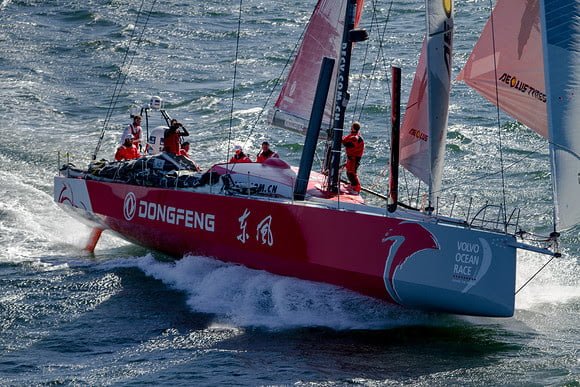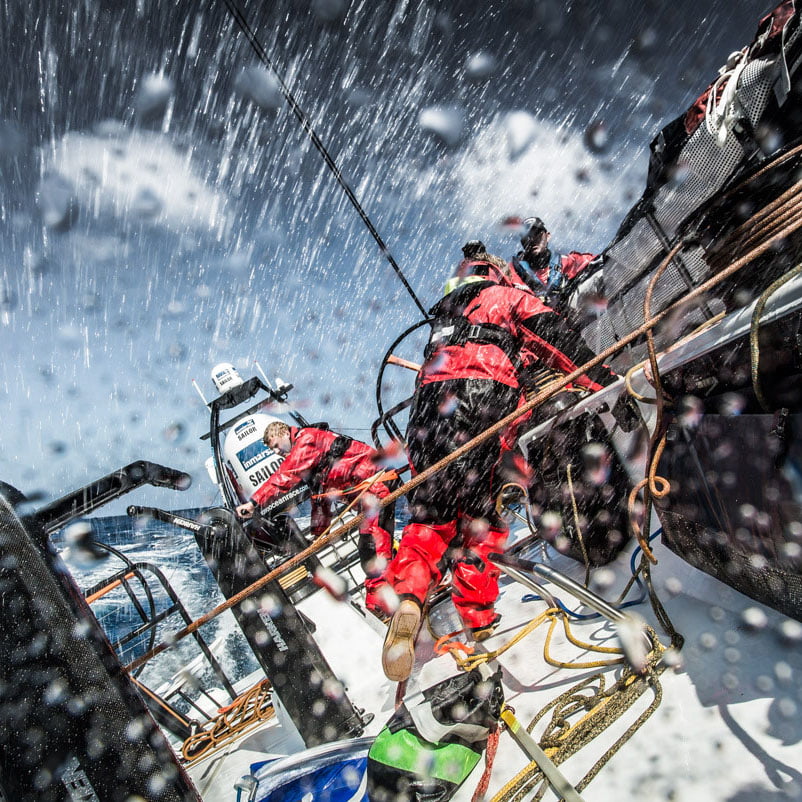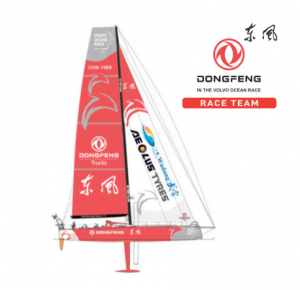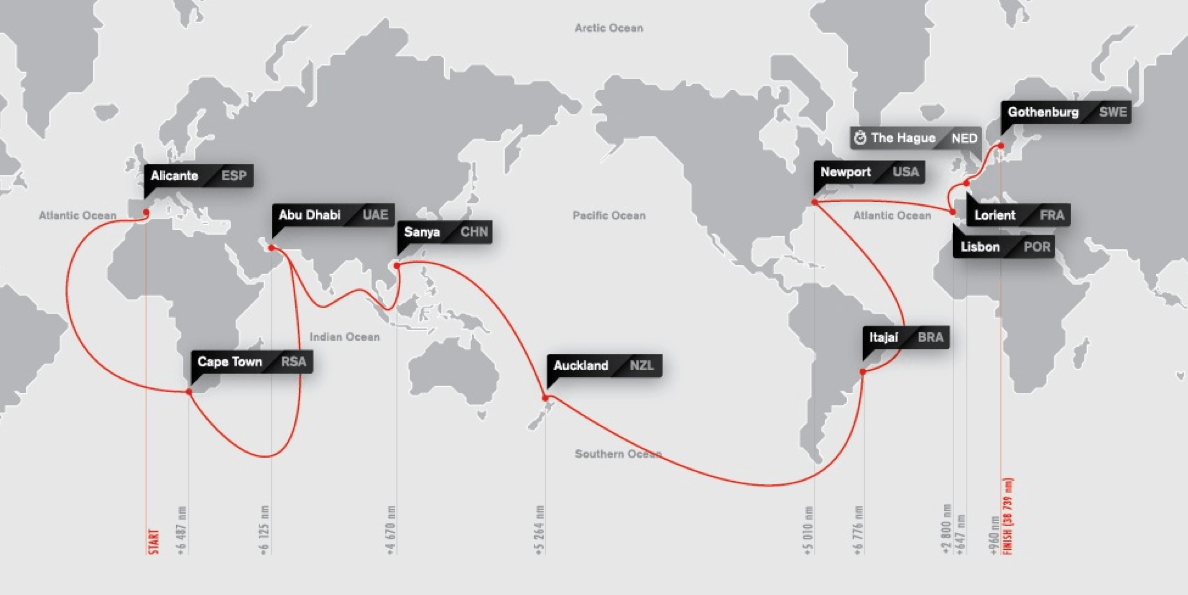After 25 days of racing just 12 minutes separated first and second place in Leg 1 of the 2014-15 Volvo Ocean race – Ed Gorman reviews the first leg and talks about boatspeed.
In the old days of the Whitbread and the early Volvo Ocean Races boatspeed was the product of two things: the designer’s pen and the ability of a crew to move a hull efficiently through the water in all conditions. The switch to a one-design contest for the first time in this year’s Volvo Ocean Race has effectively removed the designer from the equation. The boats are as near identical as it is possible to be, the sails are the same and so the onus is on the crew.
For the Dongfeng Race Team aboard the bright red Chinese-sponsored Volvo Ocean 65, boatspeed and many other of the key skills that make up a winning campaign were always going to be a struggle. Unlike their rivals Charles Caudrelier’s crew would contain two offshore novices, in the form of Chinese rookie round-the-world sailors Jiru Yang (Wolf) and Chen Jinhao (Horace), and this was expected to have an effect on all aspects of performance, not least the speed of the boat through the water.
But what leg one from Alicante to Cape Town demonstrated was that in this department at least Caudrelier has managed to square the circle because the red boat was consistently among the fastest, if not the fastest in the fleet especially off the wind when sheets were eased. The Chinese yacht was on the pace upwind but downwind she had an edge, something the crew demonstrated in straight line contests against leg winner Abu Dhabi Ocean Racing at one stage and against third placed Team Brunel.
How could this be? The answer in Caudrelier’s mind is the fact that he and several other members of his crew have big experience in solo ocean racing. Both Caudrelier and his navigator Pascal Bidegorry have won the true test in this field – the Solitaire du Figaro – and others in the crew have completed many miles at sea in solo or double-handed races. In the Solitaire you test yourself as a solo skipper against 49 other sailors in identical boats – something the Volvo Ocean Race is now asking of its crews for the first time. It is second nature for men like Caudrelier and Bidegorry to push hard for an extra tenth of a knot, to trim to perfection to squeeze out that little bit extra which, over an extended run, can lead to taking a chunk out of the boat in front or establishing a lead. What is more they are used to doing this short-handed.
Here is Caudrelier reflecting on where that speed comes from, a couple of hours after finishing in a spectacular second place into Cape Town, just 12 minutes and four seconds behind Ian Walker’s Abu Dhabi Ocean Racing after 25 days at sea.
“It can change with every leg and I don’t want to over-do this or get ahead of ourselves, but with Bruno Dubois – the team director – we chose our crew very carefully,” said Caudrelier. “On Dongfeng I have, in my view, one of the best trimmer-drivers I know in Pascal Bidegorry, and I have some exceptional drivers like Thomas Rouxel who comes from the Olympics. These guys are very, very good drivers and trimmers and they are used to fighting for speed.
“I think, from my analysis of the last Volvo Ocean Race, the game used to be about having the best boat and, if you had it, you were going fast and you didn‘t have to fight to go faster. But in a big class of one-design yachts you need to trim the sails and drive to find the speed and maybe that is why we are strong.”
Clearly another potential weakness in the Dongfeng crew might have been in manoeuvres that have to be slick at this level. But in this area the Chinese sailors have learnt fast. The pattern that developed was that in the early stages of the leg during the battle to get out of the Mediterranean in close company with other boats, the Dongfeng team struggled a bit with transitions and sail changes. But as the race settled down and the breeze stabilized in the Trade Winds, there was less to do on this score and less potential impact on performance. Even so, Cauderlier still required all eight of his team on deck for any major manoeuvre.
The Chinese sailor, Wolf, has no doubt that sail changes on Dongfeng improved as the leg went on. “It was really hard in the first three days, we were sailing close to each other and we had to push our boat. We could never sleep properly and I never got more than two hours sleep in one go so I was really tired. But once we got out of the channel (Straits of Gibralter) the wind was quite consistent, so it got better. I think we are doing better and better with our manoeuvres and sail changes.”
One knock-on effect that Caudrelier had to manage was the impact on himself and Bidegorry of needing to be on deck regularly plus the extra demands on the more experienced members of the crew over four weeks at sea. Again the more settled conditions in the second half of the leg helped offset any negative impact this might have had.
For Caudrelier and Bidegorry there were several key tactical moments. The collision when they were leading that snapped off one of the rudders more or less left them no option but to sail through the Cape Verde islands and then they lost out big-time in the Doldrums, ending up neither firmly east or west and stuck in the middle going slowly. But sparkling boatspeed in the breeze helped them recover from fourth place back into contention for the podium in the second half of the leg. The big plus-point was the decision to gybe more east than their rivals to get round the bottom of the South Atlantic High that set Dongfeng up for a fast run into Cape Town. Caudrelier believed they could win the leg right to the end. “I think we lost the race the night before we finished when we gybed,” he said. “We should have stayed inside Abu Dhabi – we gybed a bit late.”
With a big ocean leg under his belt on Dongfeng, he now knows more about how to get the best out of the new Volvo Ocean 65 boats but he says they are tricky. “They are very difficult to sail because they have less power than the Volvo 70s (used in the last race). They heel more, they are heavy and they need more sail area, so you have to find the right balance between angle of heel, sail area and power which is not easy.”
Wolf will now take a rest, handing his place to another Chinese sailor before returning for the leg three, from Abu Dhabi to Sanya. “For me I am really happy that we won second place – I am happy about that,” he said. “Only now I am a bit upset because we were so close to being champion on this leg, but that is life. You cannot expect everything that you want to happen.”
Caudrelier had nothing but praise for his path-breaking Chinese crew members. “They showed that they are prepared to work really hard and they were always there when we needed power on the winches. They are very good guys with a good spirit and they never complained,” he said.
Leg 1 Alicante to Cape Town: (6,487nm, although many more miles raced)
Finish position: 2nd, behind leg winner and pre-race favourites Abu Dhabi Ocean Racing
Time of finish: 15:22:48 UTC (12m 4s behind leg winner Abu Dhabi Ocean Racing)
Duration of leg: 25d 3h 22m
Distance sailed: 8,363nm
Best 24 hour run: Dongfeng 541nm at 1440 UTC 3.11.14 (provisional)
Volvo Ocean Race websites: www.volvooceanrace.com www.dongfengraceteam.cn




